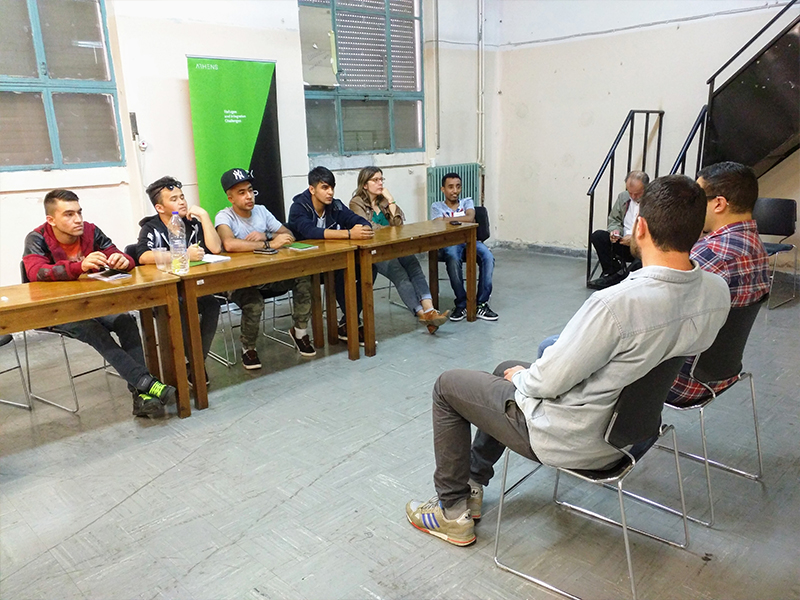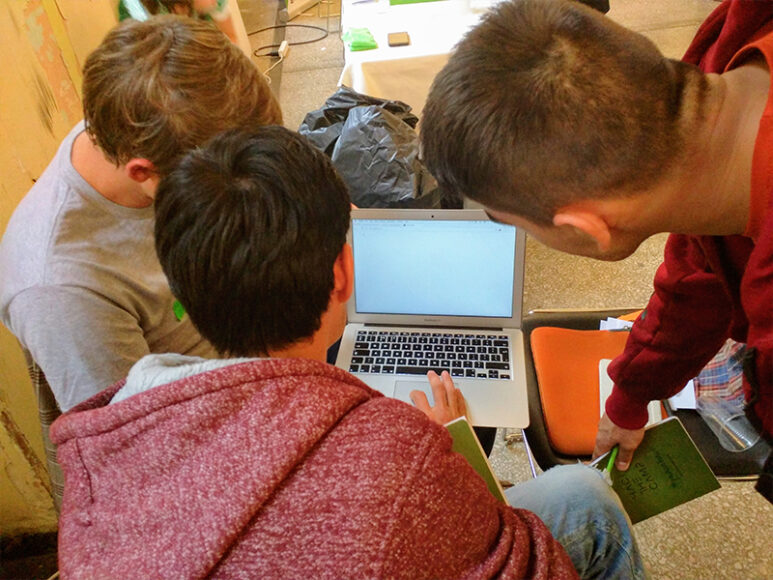
Une application pour smartphone pourrait-elle faire une différence dans la vie de certains 62,000 réfugiés et migrants en Grèce? Un outil de cartographie pourrait-il faire partie de la solution à la crise des réfugiés du pays?
Un groupe de développeurs de technologies, experts en migration et en développement, Les réfugiés et les migrants se sont rencontrés à Athènes en octobre pour essayer certaines idées technologiques qui pourraient faire exactement cela. Dans le cadre des équipes de conception et en tant qu'évaluateurs désignés de nouvelles idées, mineurs de réfugiés non accompagnés eux-mêmes, un groupe cible pour les solutions, évalué les hauteurs.
Le premier d'une paire de «hackathons,» Pirater le camp, a été un effort pour provoquer des solutions technologiques à la crise des réfugiés en Grèce. Il est soutenu par les États-Unis. Ambassade et plusieurs organisations locales et internationales, notamment Associés créatifs internationaux.
Si vous n'êtes pas familier avec les hackathons, voici un apprêt: Un hackathon est un événement de plusieurs heures (Pensez au marathon) Cela rassemble les développeurs de logiciels à utiliser leurs compétences pour prototyper leurs idées ou «pirater» des solutions ensemble en réponse à une invite fournie.
Popularisé dans le secteur technologique à but lucratif, Les hackathons sont de plus en plus détenus par les gouvernements et les organisations de la société civile pour déclencher des solutions technologiques aux problèmes de développement.
Un design qui fonctionne pour l'utilisateur
«Concevoir avec l'utilisateur,» ou "design centré sur l'homme,"Est reconnu comme le premier principe pour le développement numérique, Augmenter les chances que le nouvel outil soit effectivement utilisé par la démographie ciblée. Pourtant, cela se traduit rarement par une réalité.

Bénéficiaires ou utilisateurs finaux devrait Soyez des participants actifs dans des hackathons pour permettre un processus de conception rapide centré sur l'utilisateur.
Par exemple, Une solution sur laquelle un hack the Camp a travaillé était une plate-forme pour les histoires des réfugiés à raconter au plus grand public. Quand l'équipe a présenté son idée, Le panel de réfugiés a demandé pourquoi cela leur serait utile et s'ils tiendraient un avantage financier de la publication de leurs histoires - des points clés que l'équipe n'avait pas envisagé.
Dans un autre cas, Les réfugiés ont entendu à l'unanimité un «espace d'espace»Organisateur - qui met en place des espaces de travail collaboratifs pour l'exploration pratique et la formation, Souvent dans la technologie - pour se concentrer sur l'augmentation des compétences des utilisateurs immédiats de l'espace et les placer dans des emplois, Plutôt que d'essayer de se transformer dans plus de camps.
De cette façon, les bénéficiaires deviennent des co-concepteurs et des évaluateurs des programmes d'assistance - quelque chose que les domaines du développement et de la consolidation de la paix ont eu du mal à réaliser.
Quand j'ai demandé aux gens pourquoi ils avaient choisi de participer à Hack the Camp, Les participants à la technologie et d'autres ont mentionné l'empathie pour la population de réfugiés et le désir d'humaniser et de résoudre le problème des réfugiés.
Quand j'ai parlé à Syrian, irakien, Réfugiés afghans et pakistanais, Ils ont parlé de la façon dont ils aimaient jouer un rôle clé dans le processus créatif et inclusif.
En tout, Pirater les équipes de camp générées 33 Concepts de solution - y compris une solution de type Airbnb pour permettre aux gens de fabriquer des espaces vacants à Athènes et ailleurs disponibles pour les réfugiés. Airbnb n'est pas affilié au hackathon. Autres solutions axées sur l'éducation, emplois, santé, Planification urbaine et identité culturelle.
Des spécialistes de la conception et du développement de produits centrés sur l'homme ont guidé les équipes à travers un processus de conception rapide, Et ils ont maintenant passé les deux derniers mois à éliminer davantage les concepts.
Ce décor. 2 à 4 à Athènes, 50 Les membres des équipes sélectionnés se réassembleront au prototype et présenteront leurs solutions.
Ce que nous espérons voir, ce sont les débuts des solutions qui peuvent faire une réelle différence dans la vie de ceux qu'ils sont censés servir - la communauté des réfugiés et des migrants. Avec conception et réfugiés centrés sur l'homme dans le cadre des équipes de conception et des panneaux de rétroaction, Les perspectives pour y parvenir sont brillantes.
Ayan Kishore est directeur de Technologie pour le développement au laboratoire de développement créatif.